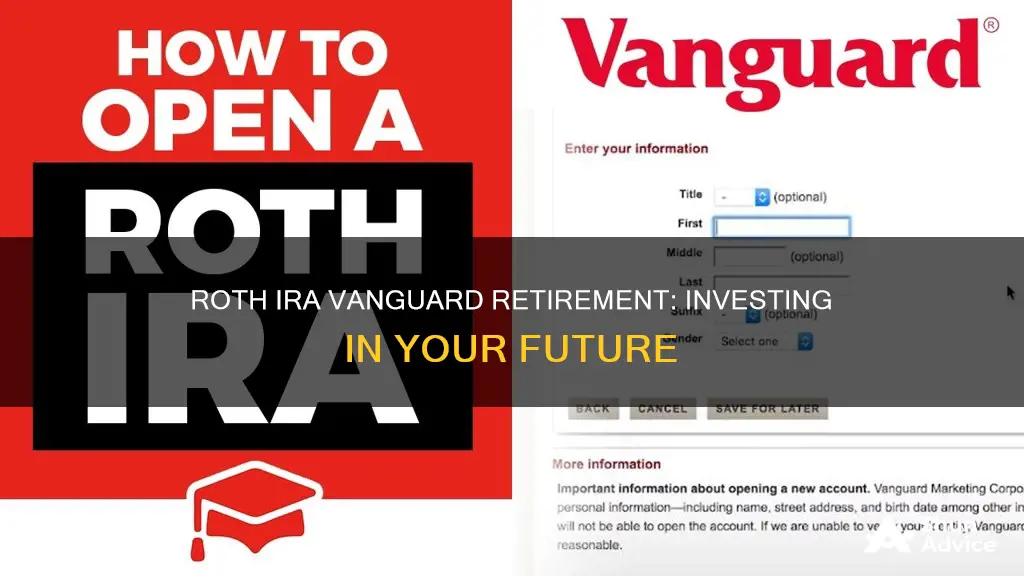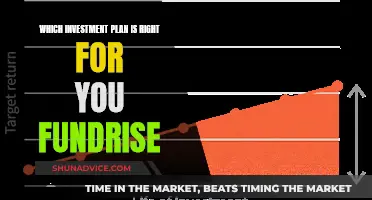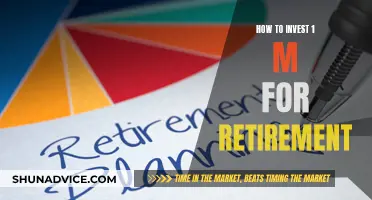
Investing in Vanguard's Target Retirement Fund is a straightforward approach to the complex problem of how to invest successfully for retirement. Each fund is designed to manage risk while helping to grow your retirement savings. The minimum investment per Target Retirement Fund is $1,000. The funds' managers gradually shift each fund's asset allocation to fewer stocks and more bonds, so the fund becomes more conservative as you get closer to retirement.
| Characteristics | Values |
|---|---|
| Minimum investment | $1,000 |
| Annual fee | $20 (waived with e-statements or $1 million in qualifying assets) |
| Investment options | Stocks, bonds, certificates of deposit, money market funds, mutual funds, exchange-traded funds |
| Automatic investments | Available for Vanguard mutual funds |
| Managed accounts | Available with Vanguard Digital Advisor |
| Managed account annual fee | No more than 0.20% of account balance |
| Managed account investment minimum | $3,000 |
What You'll Learn

How to choose the right fund for you
When choosing the right fund for you, there are a few key things to keep in mind. Firstly, consider the target date of the fund and choose one that aligns with your planned retirement year. This is important because the fund's investment mix will become more conservative as the target date approaches, with a larger allocation of bonds and other lower-risk securities. If you are many years away from retirement, you may want to choose a fund with a longer-term horizon, such as the Vanguard Target Retirement 2055 or 2060 Fund, which have a greater allocation of equities. As you get closer to retirement, you may want to consider a fund with a shorter-term horizon, such as the Vanguard Target Retirement 2025 Fund, which has a larger allocation of fixed-income investments.
Secondly, look at the glide path of the fund, which refers to how the asset allocation will change over time. Some funds have a "to" glide path, where the allocation remains fixed once the target date is reached, while others have a "through" glide path, which continues to adjust the allocation for a number of years past the target date. Choose a fund with a glide path that aligns with your investment goals and risk tolerance.
Thirdly, consider the fees associated with the fund. Target-date funds can have above-average fees, and high fees can eat into your returns over time. Look for funds with low expense ratios, such as Vanguard funds, which have an average expense ratio of 0.08%.
Finally, consider the fund's investing philosophy and make sure it aligns with your risk tolerance and investment goals. Compare different funds with the same target date to find the one with the best mix of equities and bonds for your needs. For example, the Vanguard Target Retirement 2040 Fund offers a broadly diversified portfolio with a mix of stocks, bonds, and short-term reserves.
Apple Investors: Who's Involved?
You may want to see also

The benefits of a Vanguard Roth IRA
A Vanguard Roth IRA is a great way to save for retirement. Here are some of the benefits:
Tax Advantages
A Roth IRA is a type of individual retirement account (IRA) that offers tax advantages. You contribute money that you've already paid taxes on, and your investments grow tax-free. In retirement, you can make tax-free withdrawals, meaning you don't pay any taxes on the money you take out. This can be especially beneficial if you expect to be in a higher tax bracket when you retire, as you'll be paying taxes on the money now at a lower rate.
Flexibility
With a Vanguard Roth IRA, you have flexibility in how you invest your money. You can choose from a wide range of investment options, including mutual funds, exchange-traded funds (ETFs), stocks, and bonds. This allows you to create a diverse portfolio that fits your investment goals and risk tolerance.
No Minimum Income Requirements
Unlike some retirement plans, a Roth IRA has no minimum income requirements. Anyone can contribute to a Roth IRA, regardless of their income level. This makes it a great option for those who may not qualify for other retirement plans.
No Required Minimum Distributions (RMDs)
With a Vanguard Roth IRA, you are not required to take minimum distributions during your lifetime. This means you can let your investments continue to grow tax-free for as long as you want. This is a significant advantage over traditional IRAs, which generally require you to start taking distributions at age 72.
Beneficiary Benefits
When you pass on your Roth IRA to your beneficiaries, they will also benefit from tax advantages. They won't have to pay any federal income tax on their withdrawals as long as the account has been open for at least five years. This can help maximize the value of your estate and provide tax-free income to your loved ones.
Wide Range of Investment Choices
Vanguard offers a broad range of investment options for your Roth IRA. You can choose from their low-cost mutual funds and ETFs, as well as individual stocks and bonds. You also have the option to invest in funds from other companies, giving you even more flexibility to customize your portfolio.
Planning for the Golden Years: Navigating Fidelity's Retirement Investment Options
You may want to see also

How to invest in a Vanguard target retirement fund
Investing in a Vanguard Target Retirement Fund is a "`set it and forget it"` approach to retirement savings. These funds are designed to simplify retirement investing by automatically rebalancing your portfolio from growth investments toward more conservative ones as retirement nears. Vanguard Target Retirement Funds are cheap and straightforward, offering a diversified portfolio of Vanguard broad market stock and bond index funds. Here is a step-by-step guide on how to invest in a Vanguard Target Retirement Fund:
Step 1: Understand Vanguard Target Retirement Funds
Vanguard Target Retirement Funds are designed to provide a straightforward solution to the complex problem of successfully investing for retirement. Each fund manages risk while helping to grow your retirement savings. The funds invest in Vanguard's broadest index funds, giving you access to thousands of U.S. and international stocks and bonds, providing diversification and reducing risk. The fund managers gradually shift the asset allocation from more stocks to more bonds as you get closer to retirement, making the fund more conservative.
Step 2: Choose the Right Fund for Your Timeline
Vanguard offers Target Retirement Funds with target dates ranging from 2020 to 2070. Choose the fund that aligns with your planned retirement year. For example, if you plan to retire around 2030, consider the Vanguard Target Retirement 2030 Fund (VTHRX). You can use Vanguard's table to find the fund that best fits your timeline.
Step 3: Understand the Fees and Minimum Investment
Vanguard Target Retirement Funds have a low expense ratio, which is the annual fee expressed as a percentage of your investment. The average Vanguard Target Retirement Fund expense ratio is 82% less than the industry average. The minimum investment per Target Retirement Fund is $1,000.
Step 4: Open an Account with Vanguard
To invest in a Vanguard Target Retirement Fund, you will need to open an account with Vanguard if you don't already have one. You can open an account on Vanguard's website by providing your personal information and funding the account.
Step 5: Purchase the Target Retirement Fund
Once your Vanguard account is open and funded, you can purchase the Target Retirement Fund that aligns with your retirement timeline. You can do this through Vanguard's website or app, or by contacting their customer support. Remember to consider the ongoing fees and the fund's investing philosophy when making your decision.
Step 6: Monitor Your Investment
While Vanguard Target Retirement Funds are designed to be a "set it and forget it" solution, it is important to periodically review your investment to ensure it still aligns with your retirement goals and risk tolerance. Consider checking your fund's performance and how it fits with your other investments at least once a year.
American Airlines: Invest or Avoid?
You may want to see also

The importance of checking your fund's performance
When investing in Vanguard Target Retirement Funds, it is important to regularly check the performance of your funds. Here are some reasons why:
- To assess fund manager performance: The Information Ratio (IR) is a useful measure to evaluate whether your fund manager has achieved superior risk-adjusted returns consistently. A higher IR indicates better performance compared to fund managers of similar schemes. It is calculated by dividing the active return of a portfolio (excess return due to active fund management) by the tracking error (difference between portfolio returns and the benchmark index). IR can be used to compare funds with similar investing styles and objectives.
- To understand risk-adjusted returns: Checking fund performance gives you an idea of how much risk was taken to achieve the returns generated. The IR, for instance, measures risk-adjusted returns by considering the tracking error or the standard deviation of the active return.
- To make informed investment decisions: By monitoring the performance of your funds, you can decide whether to continue investing in a particular fund or switch to another. You can compare the IR of different funds to identify those that have achieved superior risk-adjusted returns.
- To align with your investment goals and risk tolerance: Regularly reviewing fund performance helps ensure that your investments are on track to meet your financial goals. Additionally, understanding the risk-adjusted returns can help you assess if the level of risk taken aligns with your risk tolerance.
- To identify potential issues or need for rebalancing: Checking fund performance allows you to spot any issues or underperformance that may require adjustments to your investment strategy. It also helps you identify when rebalancing your portfolio may be necessary to maintain your desired asset allocation.
Remember that when checking fund performance, it is essential to consider the specific time period, compare funds with similar investing styles, and assess risk-adjusted returns to make informed decisions.
Don't Invest: When to Hold Off
You may want to see also

The advantages of target-date funds
Target-date funds are a popular choice for investors, especially in 401(k) plans, as they simplify the process of saving for retirement. Here are some advantages of target-date funds:
Simplicity and Autopilot Mode
Target-date funds are designed to be simple and straightforward, offering a "set it and forget it" approach to retirement investing. You pick a fund with a target retirement year, contribute money, and the fund managers take care of the rest, gradually adjusting the asset allocation to become more conservative as you approach retirement. This eliminates the need for constant monitoring and adjustment, reducing the stress associated with financial planning.
Diversification and Professional Management
Target-date funds provide access to a diversified portfolio of stocks, bonds, and other asset classes, both domestic and international. The funds are professionally managed, and the asset mix is maintained and rebalanced by fund managers, freeing investors from the hassle of ongoing rebalancing.
Suited for Young Investors and Long-Term Goals
Target-date funds are particularly attractive to young investors just starting their investment journey. The funds initially hold a significant portion of equities, providing the potential for higher returns over the long term. As the investor ages, the allocation shifts towards more conservative investments, such as fixed-income assets.
Flexibility and Customization
While target-date funds offer a simple approach, they also allow for customization. Investors can choose between target-date and target-risk funds. Target-date funds adjust their asset allocation based on the target retirement year, while target-risk funds offer choices based on an investor's risk tolerance (conservative, aggressive, or moderate). If your plans change, you can switch to a different fund with a more appropriate target date or risk level.
Lower Fees
Due to their increasing popularity and competition, target-date funds have seen a downward trend in fees. Their average expense ratios have become more competitive, and some funds, like Vanguard, offer expense ratios significantly below the industry average.
Despite these advantages, it is important to remember that target-date funds may not be suitable for everyone and have certain disadvantages, including potential high fees, the risk of losing value, and the possibility of becoming too conservative too quickly.
VOO: Invest Now or Later?
You may want to see also
Frequently asked questions
A Roth IRA is a tax-advantaged retirement account. You contribute money on which you’ve already paid taxes, your investments grow tax-free and you can make tax-free withdrawals in retirement.
Vanguard is one of the most well-known and well-respected brokerage firms in the US. A Vanguard Roth IRA is among the best ways to make use of this type of retirement account. The annual fee for a Vanguard Roth IRA is $20, but you can avoid this by opting for electronic statements or by having at least $1 million in qualifying assets.
A Target-Date Fund is a "set it and forget it" retirement savings option. It removes the headache of deciding on a mix of assets and rebalancing those investments over time. The fund automatically rebalances your portfolio with the right mix of stocks, bonds and money market accounts as you age.
Vanguard Target Retirement Funds give you a straightforward approach to a complex problem: how to invest successfully for retirement. Each fund is designed to manage risk while helping to grow your retirement savings. The minimum investment per Target Retirement Fund is $1,000.







